University Nursing Project: Improving Patient Education and Self-Care
VerifiedAdded on 2022/10/06
|10
|1559
|17
Project
AI Summary
This project plan focuses on improving patient education within a nursing context, emphasizing the importance of self-care and discharge planning. It employs the Lean methodology to identify and eliminate inefficiencies in the patient education process. The project includes a Work Breakdown Structure (WBS) and a budget, detailing resource allocation. The methodology involves ensuring nurse responsibility, setting hospital-wide goals, improving communication, and utilizing evaluation tools like surveys and observations. The project aims to increase patient competence and confidence for self-management. The project includes a survey with nurses to gather information on their experiences and challenges related to patient education, and it uses various measurement tools such as Gross profit margin, earned value analysis, and customer satisfaction to assess the project's success. The ultimate goal is to enhance patient independence and improve the quality of care, as detailed in this student-contributed project plan available on Desklib.
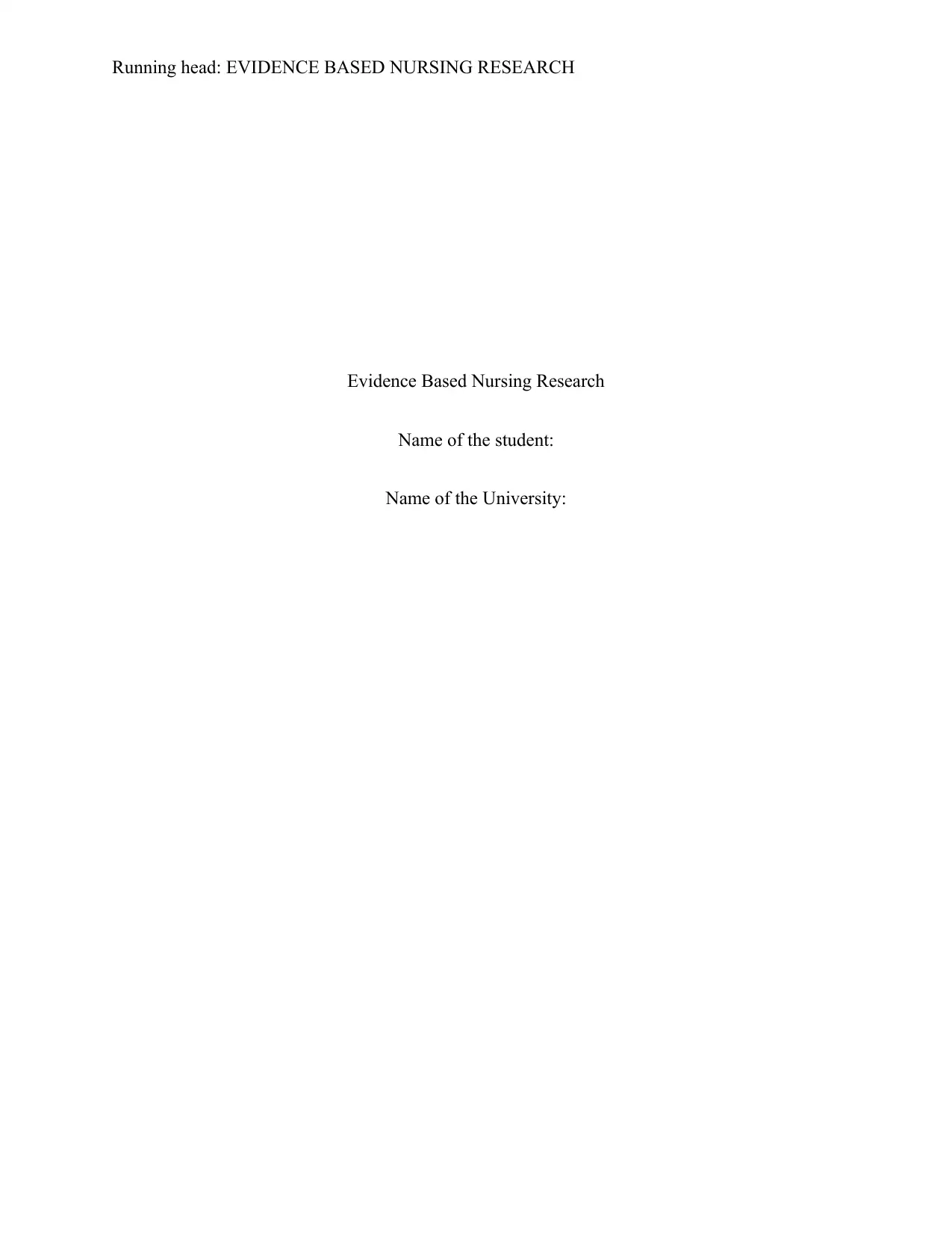
Running head: EVIDENCE BASED NURSING RESEARCH
Evidence Based Nursing Research
Name of the student:
Name of the University:
Evidence Based Nursing Research
Name of the student:
Name of the University:
Paraphrase This Document
Need a fresh take? Get an instant paraphrase of this document with our AI Paraphraser
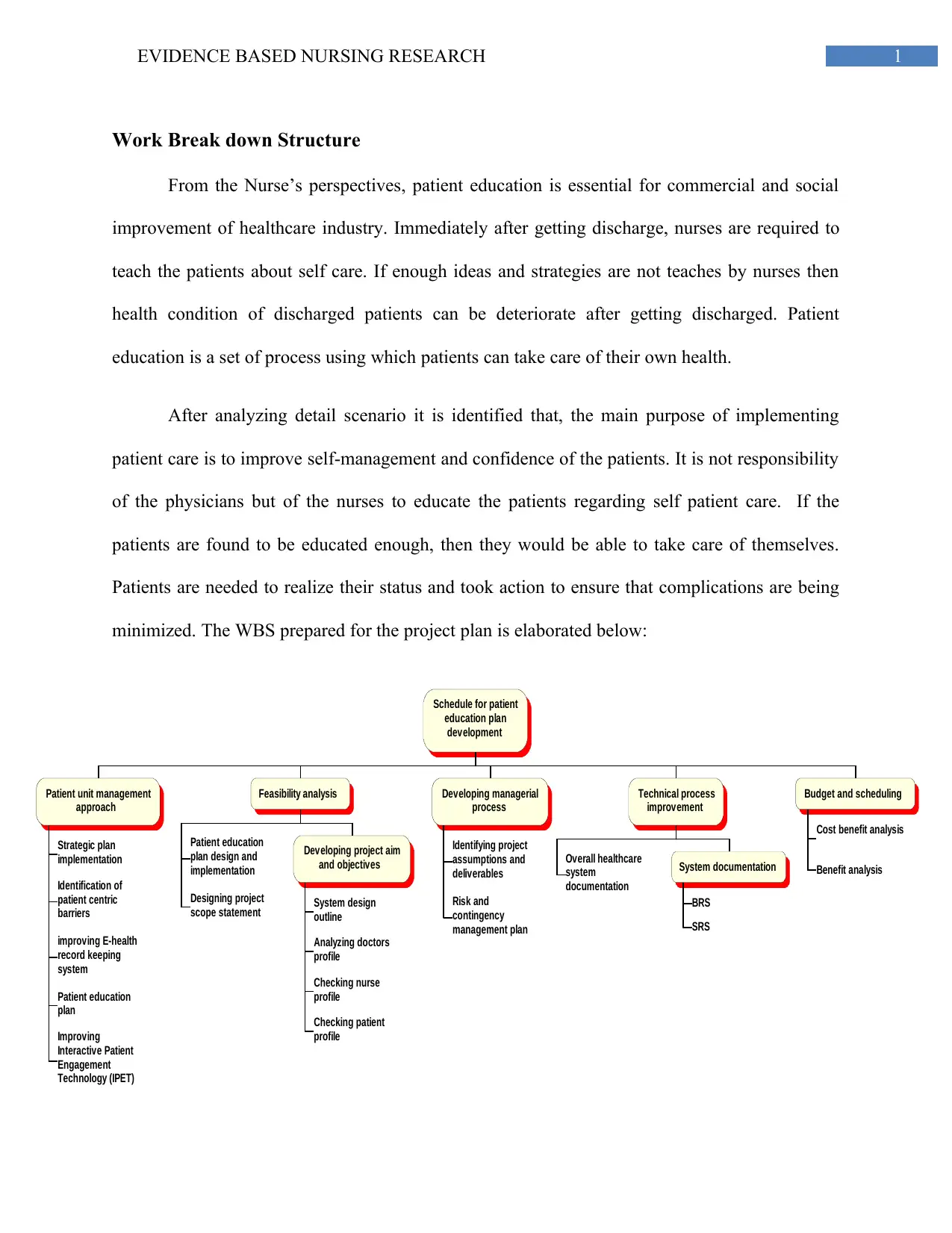
1EVIDENCE BASED NURSING RESEARCH
Work Break down Structure
From the Nurse’s perspectives, patient education is essential for commercial and social
improvement of healthcare industry. Immediately after getting discharge, nurses are required to
teach the patients about self care. If enough ideas and strategies are not teaches by nurses then
health condition of discharged patients can be deteriorate after getting discharged. Patient
education is a set of process using which patients can take care of their own health.
After analyzing detail scenario it is identified that, the main purpose of implementing
patient care is to improve self-management and confidence of the patients. It is not responsibility
of the physicians but of the nurses to educate the patients regarding self patient care. If the
patients are found to be educated enough, then they would be able to take care of themselves.
Patients are needed to realize their status and took action to ensure that complications are being
minimized. The WBS prepared for the project plan is elaborated below:
Schedule for patient
education plan
development
Patient unit management
approach
Strategic plan
implementation
Identification of
patient centric
barriers
improving E-health
record keeping
system
Patient education
plan
Improving
Interactive Patient
Engagement
Technology (IPET)
Feasibility analysis
Patient education
plan design and
implementation
Designing project
scope statement
Developing project aim
and objectives
System design
outline
Analyzing doctors
profile
Checking nurse
profile
Checking patient
profile
Developing managerial
process
Identifying project
assumptions and
deliverables
Risk and
contingency
management plan
Technical process
improvement
Overall healthcare
system
documentation
System documentation
BRS
SRS
Budget and scheduling
Cost benefit analysis
Benefit analysis
Work Break down Structure
From the Nurse’s perspectives, patient education is essential for commercial and social
improvement of healthcare industry. Immediately after getting discharge, nurses are required to
teach the patients about self care. If enough ideas and strategies are not teaches by nurses then
health condition of discharged patients can be deteriorate after getting discharged. Patient
education is a set of process using which patients can take care of their own health.
After analyzing detail scenario it is identified that, the main purpose of implementing
patient care is to improve self-management and confidence of the patients. It is not responsibility
of the physicians but of the nurses to educate the patients regarding self patient care. If the
patients are found to be educated enough, then they would be able to take care of themselves.
Patients are needed to realize their status and took action to ensure that complications are being
minimized. The WBS prepared for the project plan is elaborated below:
Schedule for patient
education plan
development
Patient unit management
approach
Strategic plan
implementation
Identification of
patient centric
barriers
improving E-health
record keeping
system
Patient education
plan
Improving
Interactive Patient
Engagement
Technology (IPET)
Feasibility analysis
Patient education
plan design and
implementation
Designing project
scope statement
Developing project aim
and objectives
System design
outline
Analyzing doctors
profile
Checking nurse
profile
Checking patient
profile
Developing managerial
process
Identifying project
assumptions and
deliverables
Risk and
contingency
management plan
Technical process
improvement
Overall healthcare
system
documentation
System documentation
BRS
SRS
Budget and scheduling
Cost benefit analysis
Benefit analysis
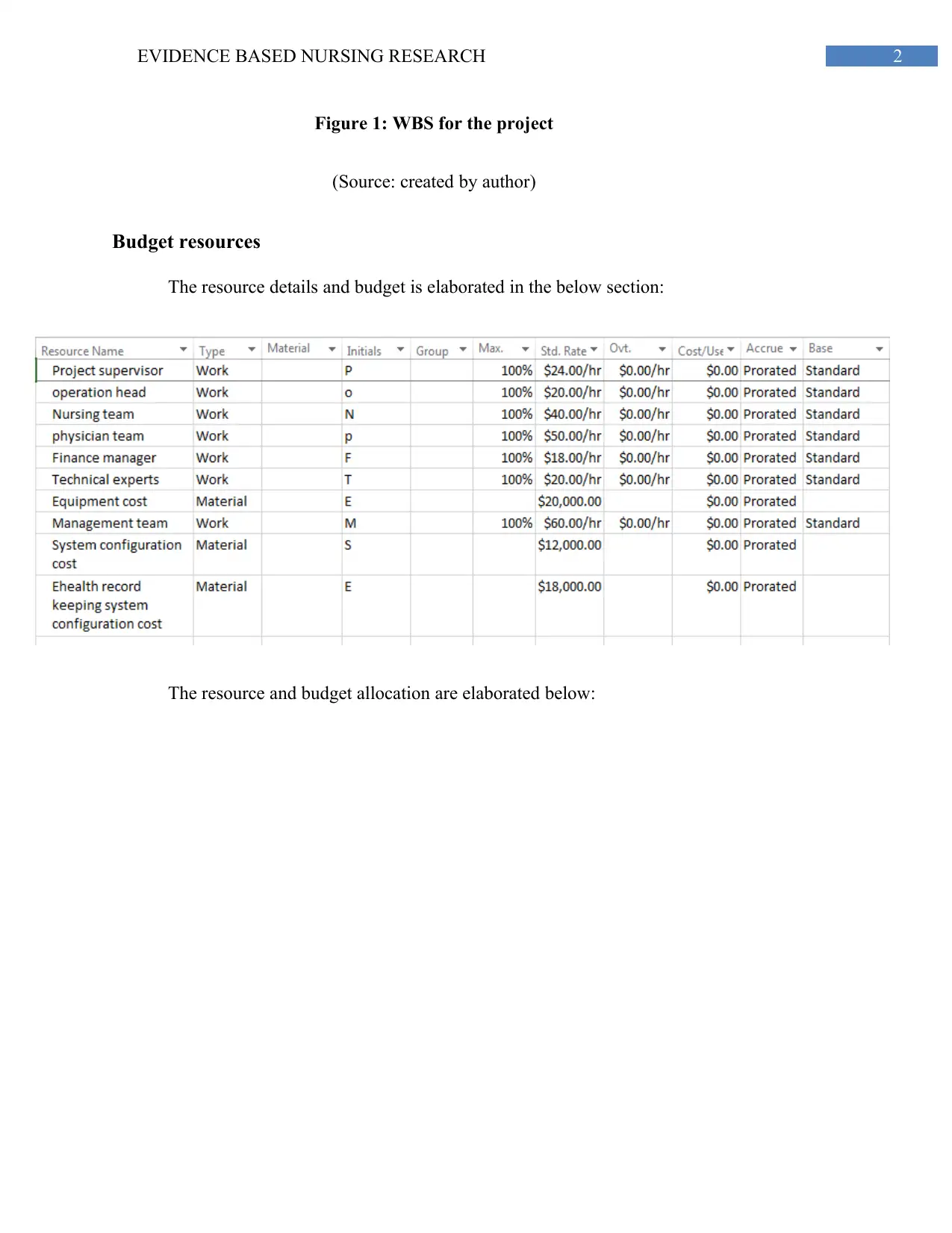
2EVIDENCE BASED NURSING RESEARCH
Figure 1: WBS for the project
(Source: created by author)
Budget resources
The resource details and budget is elaborated in the below section:
The resource and budget allocation are elaborated below:
Figure 1: WBS for the project
(Source: created by author)
Budget resources
The resource details and budget is elaborated in the below section:
The resource and budget allocation are elaborated below:
⊘ This is a preview!⊘
Do you want full access?
Subscribe today to unlock all pages.

Trusted by 1+ million students worldwide
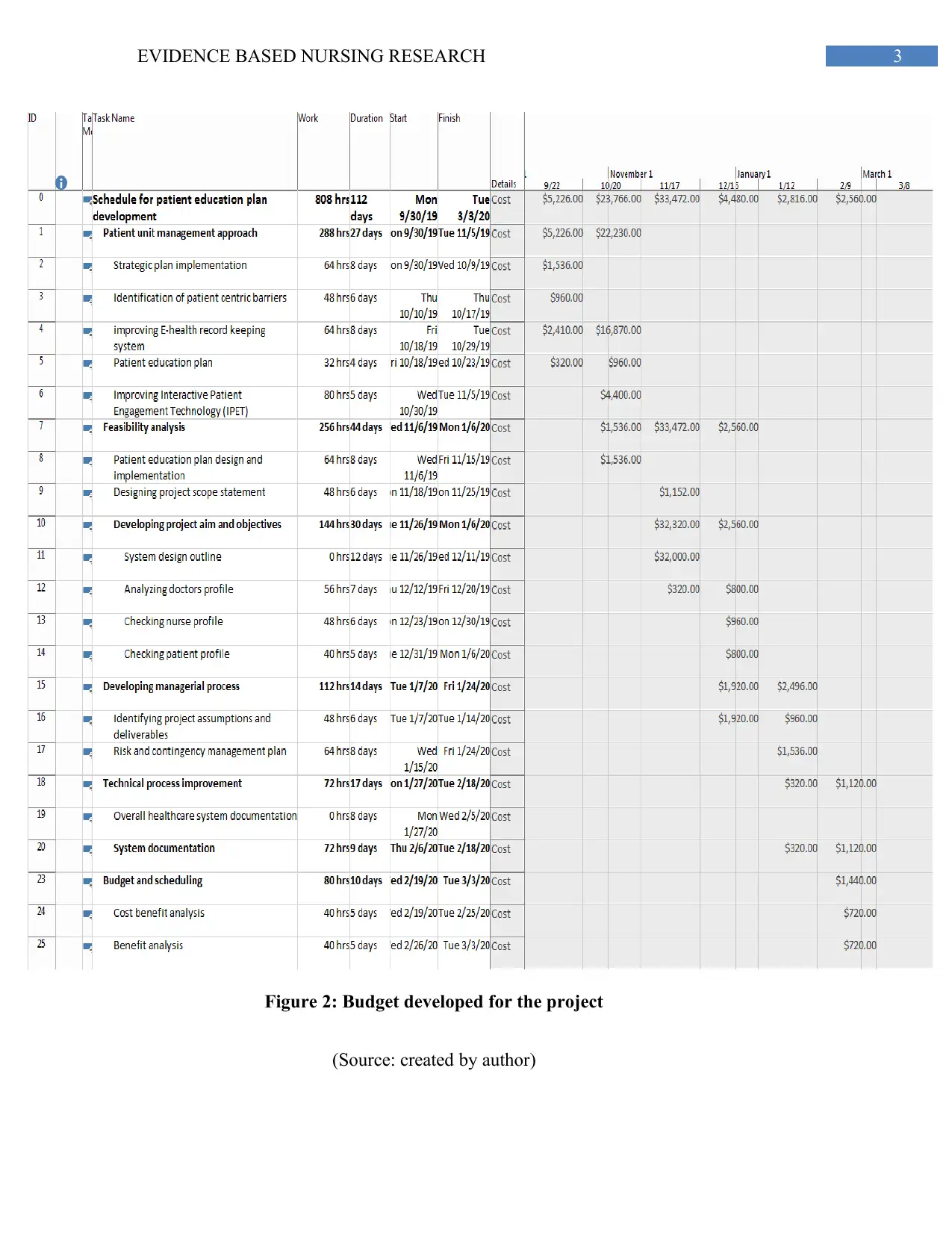
3EVIDENCE BASED NURSING RESEARCH
Figure 2: Budget developed for the project
(Source: created by author)
Figure 2: Budget developed for the project
(Source: created by author)
Paraphrase This Document
Need a fresh take? Get an instant paraphrase of this document with our AI Paraphraser
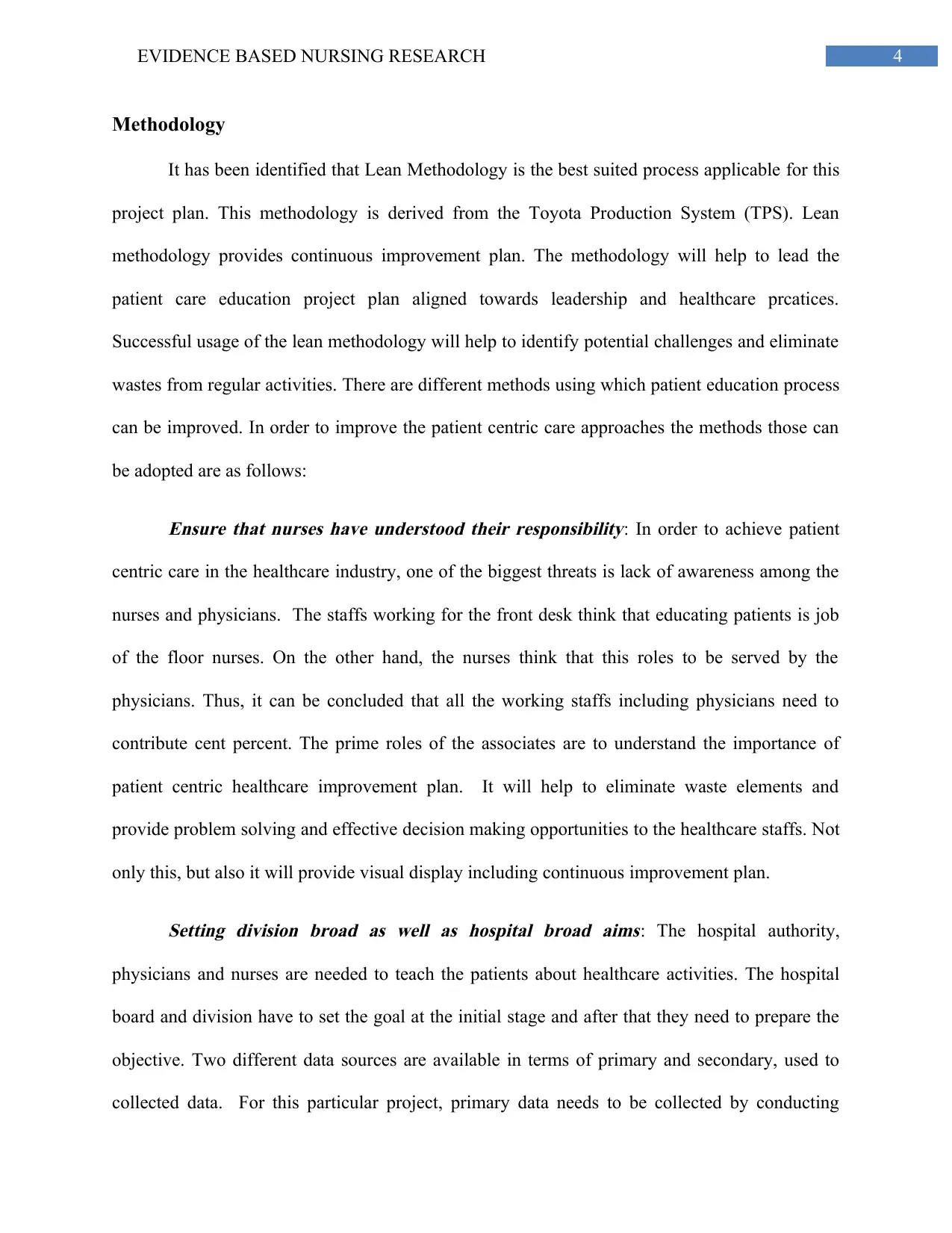
4EVIDENCE BASED NURSING RESEARCH
Methodology
It has been identified that Lean Methodology is the best suited process applicable for this
project plan. This methodology is derived from the Toyota Production System (TPS). Lean
methodology provides continuous improvement plan. The methodology will help to lead the
patient care education project plan aligned towards leadership and healthcare prcatices.
Successful usage of the lean methodology will help to identify potential challenges and eliminate
wastes from regular activities. There are different methods using which patient education process
can be improved. In order to improve the patient centric care approaches the methods those can
be adopted are as follows:
Ensure that nurses have understood their responsibility: In order to achieve patient
centric care in the healthcare industry, one of the biggest threats is lack of awareness among the
nurses and physicians. The staffs working for the front desk think that educating patients is job
of the floor nurses. On the other hand, the nurses think that this roles to be served by the
physicians. Thus, it can be concluded that all the working staffs including physicians need to
contribute cent percent. The prime roles of the associates are to understand the importance of
patient centric healthcare improvement plan. It will help to eliminate waste elements and
provide problem solving and effective decision making opportunities to the healthcare staffs. Not
only this, but also it will provide visual display including continuous improvement plan.
Setting division broad as well as hospital broad aims: The hospital authority,
physicians and nurses are needed to teach the patients about healthcare activities. The hospital
board and division have to set the goal at the initial stage and after that they need to prepare the
objective. Two different data sources are available in terms of primary and secondary, used to
collected data. For this particular project, primary data needs to be collected by conducting
Methodology
It has been identified that Lean Methodology is the best suited process applicable for this
project plan. This methodology is derived from the Toyota Production System (TPS). Lean
methodology provides continuous improvement plan. The methodology will help to lead the
patient care education project plan aligned towards leadership and healthcare prcatices.
Successful usage of the lean methodology will help to identify potential challenges and eliminate
wastes from regular activities. There are different methods using which patient education process
can be improved. In order to improve the patient centric care approaches the methods those can
be adopted are as follows:
Ensure that nurses have understood their responsibility: In order to achieve patient
centric care in the healthcare industry, one of the biggest threats is lack of awareness among the
nurses and physicians. The staffs working for the front desk think that educating patients is job
of the floor nurses. On the other hand, the nurses think that this roles to be served by the
physicians. Thus, it can be concluded that all the working staffs including physicians need to
contribute cent percent. The prime roles of the associates are to understand the importance of
patient centric healthcare improvement plan. It will help to eliminate waste elements and
provide problem solving and effective decision making opportunities to the healthcare staffs. Not
only this, but also it will provide visual display including continuous improvement plan.
Setting division broad as well as hospital broad aims: The hospital authority,
physicians and nurses are needed to teach the patients about healthcare activities. The hospital
board and division have to set the goal at the initial stage and after that they need to prepare the
objective. Two different data sources are available in terms of primary and secondary, used to
collected data. For this particular project, primary data needs to be collected by conducting
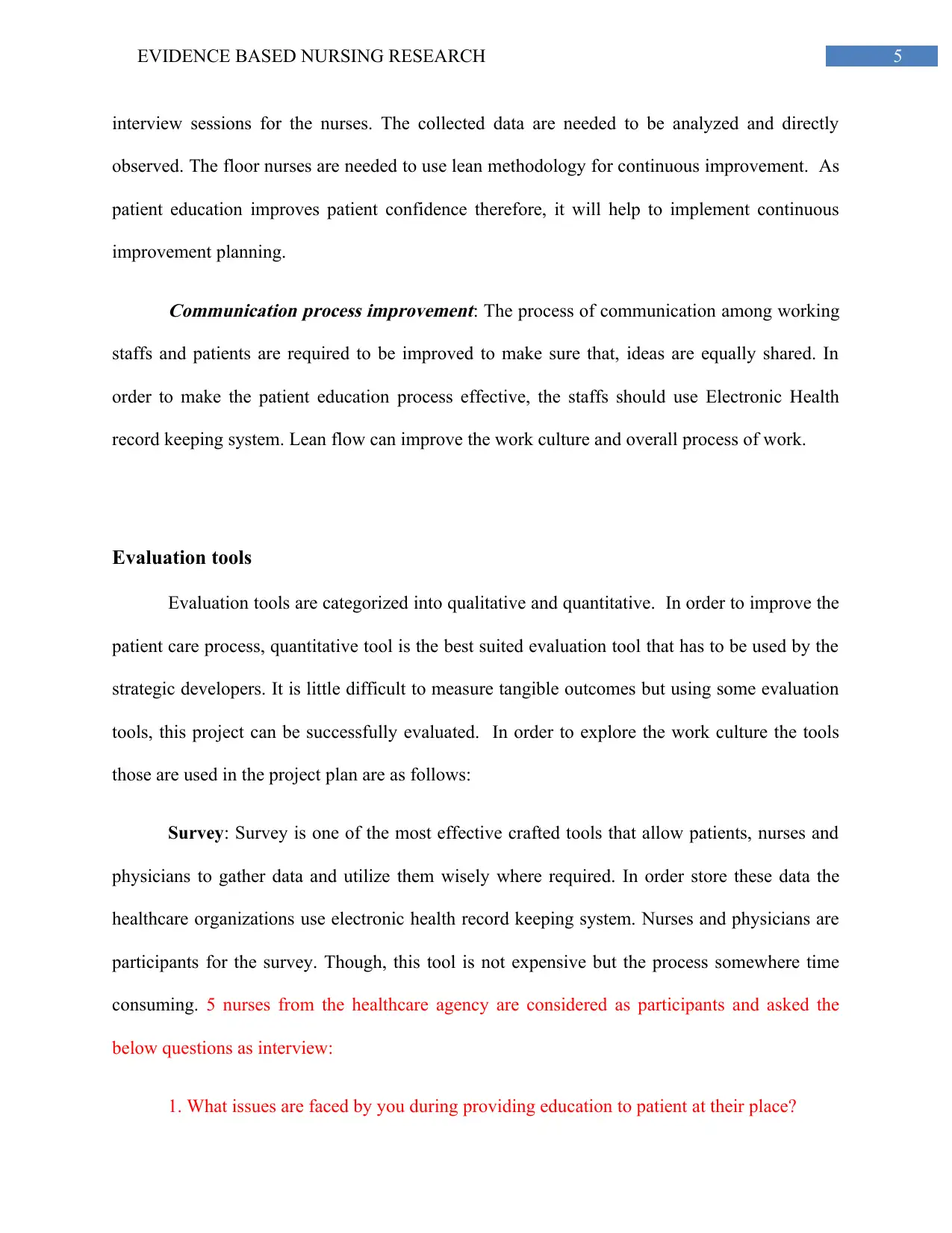
5EVIDENCE BASED NURSING RESEARCH
interview sessions for the nurses. The collected data are needed to be analyzed and directly
observed. The floor nurses are needed to use lean methodology for continuous improvement. As
patient education improves patient confidence therefore, it will help to implement continuous
improvement planning.
Communication process improvement: The process of communication among working
staffs and patients are required to be improved to make sure that, ideas are equally shared. In
order to make the patient education process effective, the staffs should use Electronic Health
record keeping system. Lean flow can improve the work culture and overall process of work.
Evaluation tools
Evaluation tools are categorized into qualitative and quantitative. In order to improve the
patient care process, quantitative tool is the best suited evaluation tool that has to be used by the
strategic developers. It is little difficult to measure tangible outcomes but using some evaluation
tools, this project can be successfully evaluated. In order to explore the work culture the tools
those are used in the project plan are as follows:
Survey: Survey is one of the most effective crafted tools that allow patients, nurses and
physicians to gather data and utilize them wisely where required. In order store these data the
healthcare organizations use electronic health record keeping system. Nurses and physicians are
participants for the survey. Though, this tool is not expensive but the process somewhere time
consuming. 5 nurses from the healthcare agency are considered as participants and asked the
below questions as interview:
1. What issues are faced by you during providing education to patient at their place?
interview sessions for the nurses. The collected data are needed to be analyzed and directly
observed. The floor nurses are needed to use lean methodology for continuous improvement. As
patient education improves patient confidence therefore, it will help to implement continuous
improvement planning.
Communication process improvement: The process of communication among working
staffs and patients are required to be improved to make sure that, ideas are equally shared. In
order to make the patient education process effective, the staffs should use Electronic Health
record keeping system. Lean flow can improve the work culture and overall process of work.
Evaluation tools
Evaluation tools are categorized into qualitative and quantitative. In order to improve the
patient care process, quantitative tool is the best suited evaluation tool that has to be used by the
strategic developers. It is little difficult to measure tangible outcomes but using some evaluation
tools, this project can be successfully evaluated. In order to explore the work culture the tools
those are used in the project plan are as follows:
Survey: Survey is one of the most effective crafted tools that allow patients, nurses and
physicians to gather data and utilize them wisely where required. In order store these data the
healthcare organizations use electronic health record keeping system. Nurses and physicians are
participants for the survey. Though, this tool is not expensive but the process somewhere time
consuming. 5 nurses from the healthcare agency are considered as participants and asked the
below questions as interview:
1. What issues are faced by you during providing education to patient at their place?
⊘ This is a preview!⊘
Do you want full access?
Subscribe today to unlock all pages.

Trusted by 1+ million students worldwide
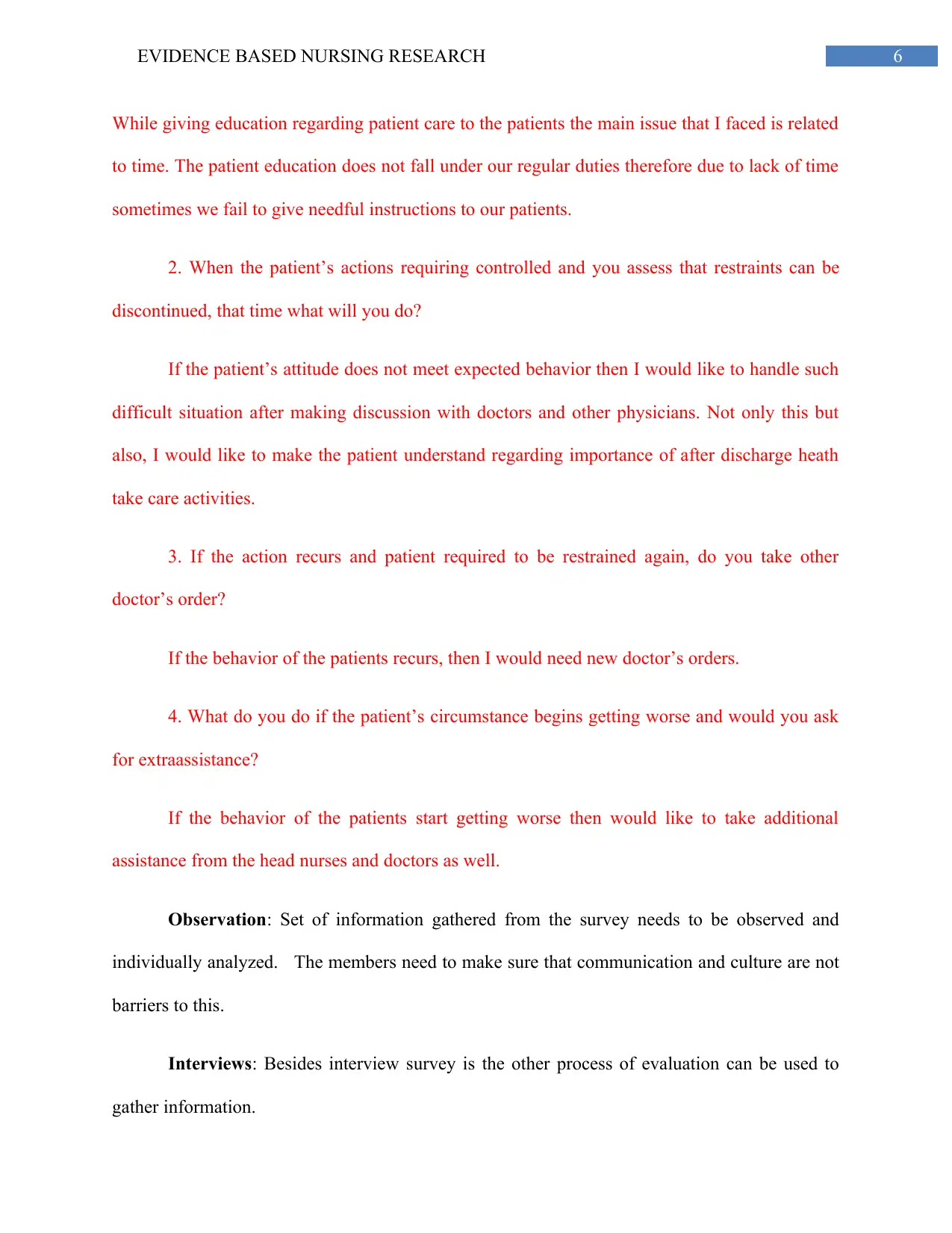
6EVIDENCE BASED NURSING RESEARCH
While giving education regarding patient care to the patients the main issue that I faced is related
to time. The patient education does not fall under our regular duties therefore due to lack of time
sometimes we fail to give needful instructions to our patients.
2. When the patient’s actions requiring controlled and you assess that restraints can be
discontinued, that time what will you do?
If the patient’s attitude does not meet expected behavior then I would like to handle such
difficult situation after making discussion with doctors and other physicians. Not only this but
also, I would like to make the patient understand regarding importance of after discharge heath
take care activities.
3. If the action recurs and patient required to be restrained again, do you take other
doctor’s order?
If the behavior of the patients recurs, then I would need new doctor’s orders.
4. What do you do if the patient’s circumstance begins getting worse and would you ask
for extraassistance?
If the behavior of the patients start getting worse then would like to take additional
assistance from the head nurses and doctors as well.
Observation: Set of information gathered from the survey needs to be observed and
individually analyzed. The members need to make sure that communication and culture are not
barriers to this.
Interviews: Besides interview survey is the other process of evaluation can be used to
gather information.
While giving education regarding patient care to the patients the main issue that I faced is related
to time. The patient education does not fall under our regular duties therefore due to lack of time
sometimes we fail to give needful instructions to our patients.
2. When the patient’s actions requiring controlled and you assess that restraints can be
discontinued, that time what will you do?
If the patient’s attitude does not meet expected behavior then I would like to handle such
difficult situation after making discussion with doctors and other physicians. Not only this but
also, I would like to make the patient understand regarding importance of after discharge heath
take care activities.
3. If the action recurs and patient required to be restrained again, do you take other
doctor’s order?
If the behavior of the patients recurs, then I would need new doctor’s orders.
4. What do you do if the patient’s circumstance begins getting worse and would you ask
for extraassistance?
If the behavior of the patients start getting worse then would like to take additional
assistance from the head nurses and doctors as well.
Observation: Set of information gathered from the survey needs to be observed and
individually analyzed. The members need to make sure that communication and culture are not
barriers to this.
Interviews: Besides interview survey is the other process of evaluation can be used to
gather information.
Paraphrase This Document
Need a fresh take? Get an instant paraphrase of this document with our AI Paraphraser
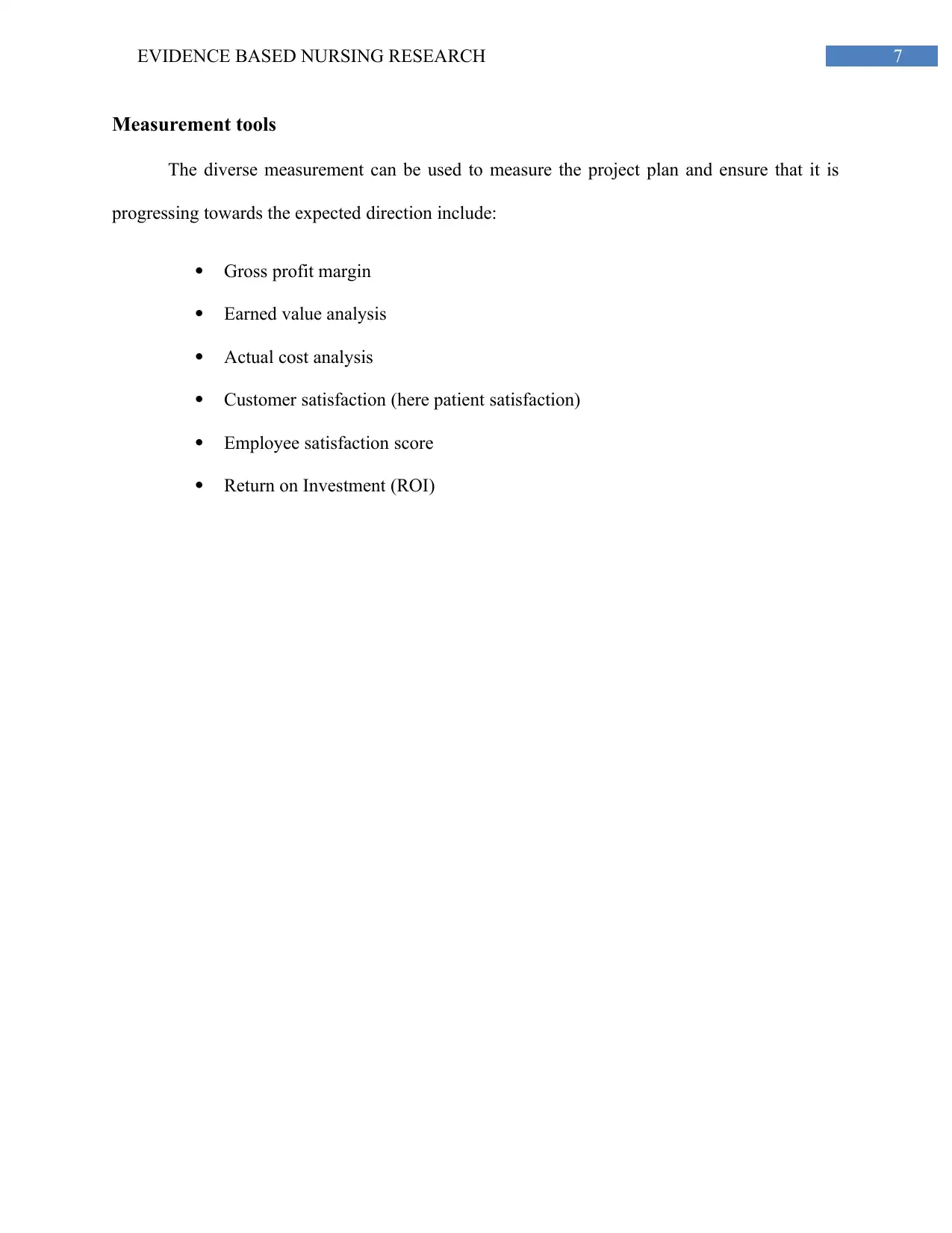
7EVIDENCE BASED NURSING RESEARCH
Measurement tools
The diverse measurement can be used to measure the project plan and ensure that it is
progressing towards the expected direction include:
Gross profit margin
Earned value analysis
Actual cost analysis
Customer satisfaction (here patient satisfaction)
Employee satisfaction score
Return on Investment (ROI)
Measurement tools
The diverse measurement can be used to measure the project plan and ensure that it is
progressing towards the expected direction include:
Gross profit margin
Earned value analysis
Actual cost analysis
Customer satisfaction (here patient satisfaction)
Employee satisfaction score
Return on Investment (ROI)
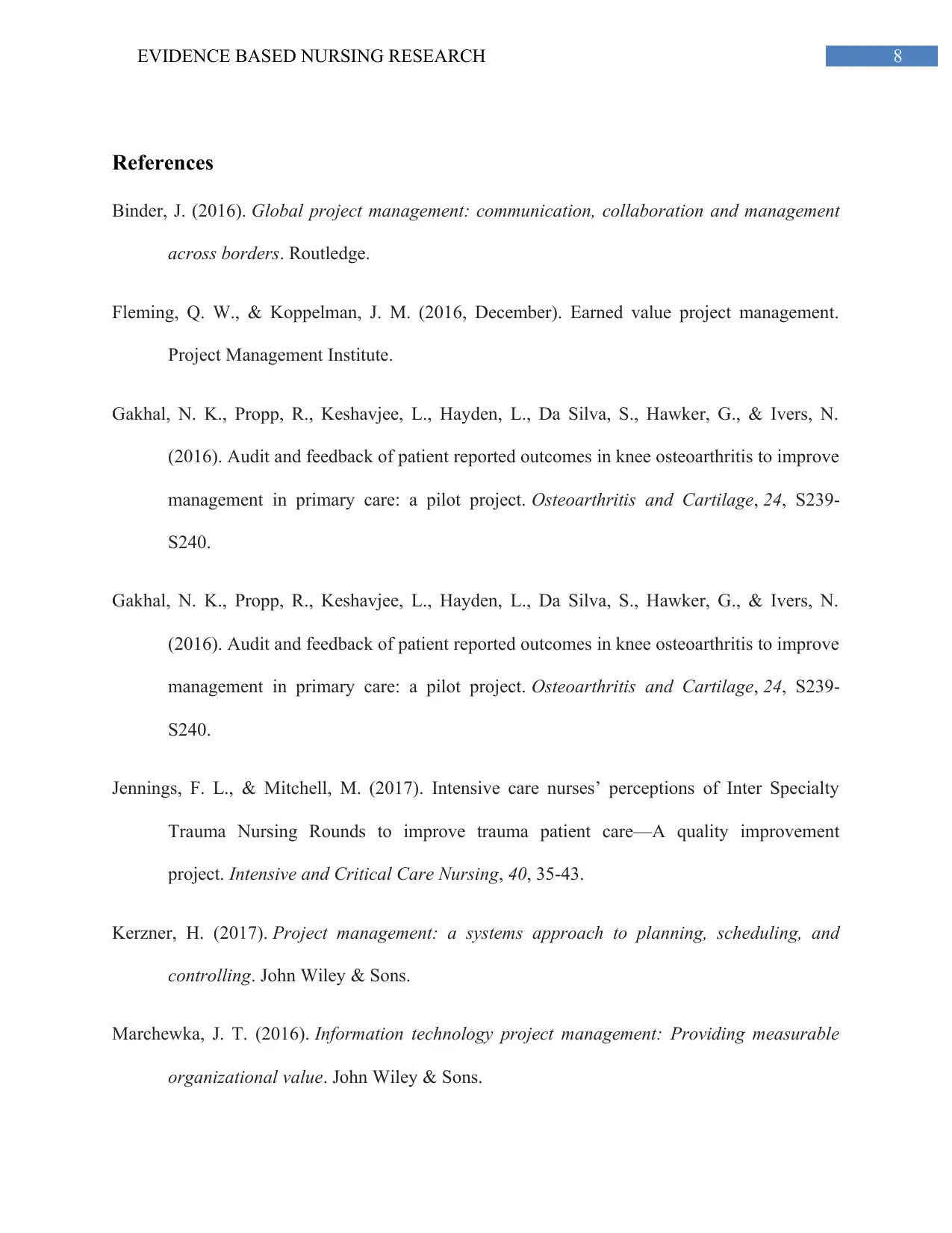
8EVIDENCE BASED NURSING RESEARCH
References
Binder, J. (2016). Global project management: communication, collaboration and management
across borders. Routledge.
Fleming, Q. W., & Koppelman, J. M. (2016, December). Earned value project management.
Project Management Institute.
Gakhal, N. K., Propp, R., Keshavjee, L., Hayden, L., Da Silva, S., Hawker, G., & Ivers, N.
(2016). Audit and feedback of patient reported outcomes in knee osteoarthritis to improve
management in primary care: a pilot project. Osteoarthritis and Cartilage, 24, S239-
S240.
Gakhal, N. K., Propp, R., Keshavjee, L., Hayden, L., Da Silva, S., Hawker, G., & Ivers, N.
(2016). Audit and feedback of patient reported outcomes in knee osteoarthritis to improve
management in primary care: a pilot project. Osteoarthritis and Cartilage, 24, S239-
S240.
Jennings, F. L., & Mitchell, M. (2017). Intensive care nurses’ perceptions of Inter Specialty
Trauma Nursing Rounds to improve trauma patient care—A quality improvement
project. Intensive and Critical Care Nursing, 40, 35-43.
Kerzner, H. (2017). Project management: a systems approach to planning, scheduling, and
controlling. John Wiley & Sons.
Marchewka, J. T. (2016). Information technology project management: Providing measurable
organizational value. John Wiley & Sons.
References
Binder, J. (2016). Global project management: communication, collaboration and management
across borders. Routledge.
Fleming, Q. W., & Koppelman, J. M. (2016, December). Earned value project management.
Project Management Institute.
Gakhal, N. K., Propp, R., Keshavjee, L., Hayden, L., Da Silva, S., Hawker, G., & Ivers, N.
(2016). Audit and feedback of patient reported outcomes in knee osteoarthritis to improve
management in primary care: a pilot project. Osteoarthritis and Cartilage, 24, S239-
S240.
Gakhal, N. K., Propp, R., Keshavjee, L., Hayden, L., Da Silva, S., Hawker, G., & Ivers, N.
(2016). Audit and feedback of patient reported outcomes in knee osteoarthritis to improve
management in primary care: a pilot project. Osteoarthritis and Cartilage, 24, S239-
S240.
Jennings, F. L., & Mitchell, M. (2017). Intensive care nurses’ perceptions of Inter Specialty
Trauma Nursing Rounds to improve trauma patient care—A quality improvement
project. Intensive and Critical Care Nursing, 40, 35-43.
Kerzner, H. (2017). Project management: a systems approach to planning, scheduling, and
controlling. John Wiley & Sons.
Marchewka, J. T. (2016). Information technology project management: Providing measurable
organizational value. John Wiley & Sons.
⊘ This is a preview!⊘
Do you want full access?
Subscribe today to unlock all pages.

Trusted by 1+ million students worldwide
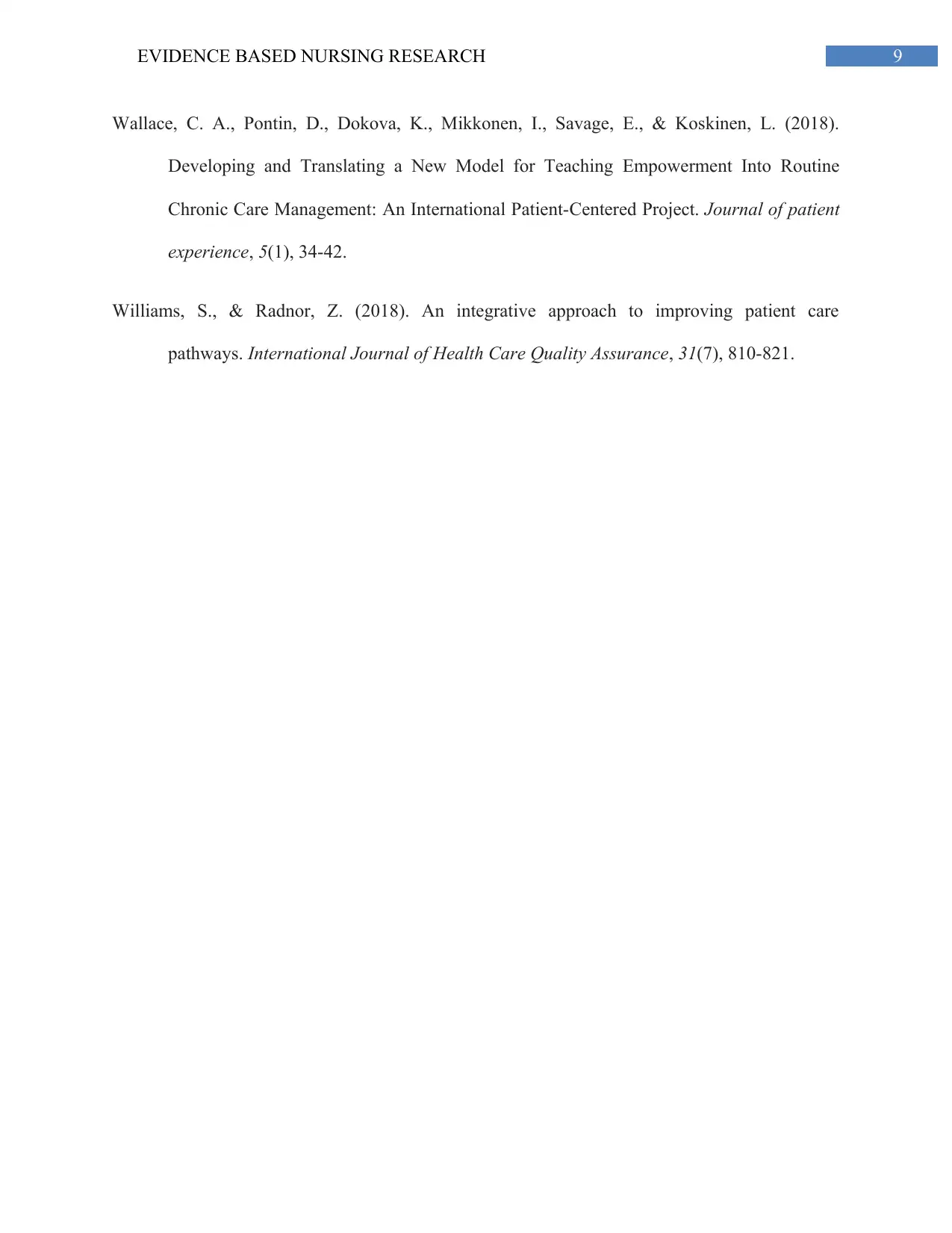
9EVIDENCE BASED NURSING RESEARCH
Wallace, C. A., Pontin, D., Dokova, K., Mikkonen, I., Savage, E., & Koskinen, L. (2018).
Developing and Translating a New Model for Teaching Empowerment Into Routine
Chronic Care Management: An International Patient-Centered Project. Journal of patient
experience, 5(1), 34-42.
Williams, S., & Radnor, Z. (2018). An integrative approach to improving patient care
pathways. International Journal of Health Care Quality Assurance, 31(7), 810-821.
Wallace, C. A., Pontin, D., Dokova, K., Mikkonen, I., Savage, E., & Koskinen, L. (2018).
Developing and Translating a New Model for Teaching Empowerment Into Routine
Chronic Care Management: An International Patient-Centered Project. Journal of patient
experience, 5(1), 34-42.
Williams, S., & Radnor, Z. (2018). An integrative approach to improving patient care
pathways. International Journal of Health Care Quality Assurance, 31(7), 810-821.
1 out of 10
Related Documents
Your All-in-One AI-Powered Toolkit for Academic Success.
+13062052269
info@desklib.com
Available 24*7 on WhatsApp / Email
![[object Object]](/_next/static/media/star-bottom.7253800d.svg)
Unlock your academic potential
Copyright © 2020–2025 A2Z Services. All Rights Reserved. Developed and managed by ZUCOL.





